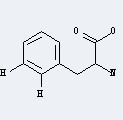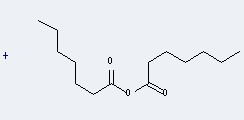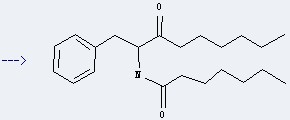-
Name
HEPTANOIC ANHYDRIDE
- EINECS 210-940-5
- CAS No. 626-27-7
- Article Data22
- CAS DataBase
- Density 0.931 g/cm3
- Solubility
- Melting Point -12 °C
- Formula C14H26O3
- Boiling Point 269.5 °C at 760 mmHg
- Molecular Weight 242.359
- Flash Point 129.9 °C
- Transport Information
- Appearance clear light yellow liquid
- Safety 45-36/37/39-26-28
- Risk Codes 34
-
Molecular Structure
-
Hazard Symbols
 C
C
- Synonyms Heptanoicacid, anhydride (9CI);Heptanoic anhydride (6CI,7CI,8CI);Enanthic anhydride;Heptanoyl anhydride;NSC 67902;n-Heptanoic acid anhydride;
- PSA 43.37000
- LogP 3.99700
Heptanoic anhydride Specification
The IUPAC name of Heptanoic anhydride is Heptanoyl heptanoate. With the CAS registry number 626-27-7, it is also named as Heptanoic acid anhydride. The product's category is Pharmaceutical Intermediates. Besides, it is clear light yellow liquid, which should be stored in sealed containers and placed in a cool, dry place. In addition, its molecular formula is C14H26O3 and molecular weight is 242.35.
The other characteristics of this product can be summarized as: (1)EINECS: 210-940-5; (2)ACD/LogP: 4.83; (3)# of Rule of 5 Violations: 0; (4)ACD/LogD (pH 5.5): 4.83; (5)ACD/LogD (pH 7.4): 4.83; (6)ACD/BCF (pH 5.5): 2761.32; (7)ACD/BCF (pH 7.4): 2761.32; (8)ACD/KOC (pH 5.5): 10109.89; (9)ACD/KOC (pH 7.4): 10109.89; (10)H bond acceptors: 3; (11)H bond donors: 0; (12)Freely Rotating Bonds: 12; (13)Polar Surface Area: 43.37 Å2; (14)Index of Refraction: 1.44; (15)Molar Refractivity: 68.71 cm3; (16)Molar Volume: 260.2 cm3; (17)Polarizability: 27.24×10-24cm3; (18)Surface Tension: 31.9 dyne/cm; (19)Density: 0.931 g/cm3; (20)Flash Point: 129.9 °C; (21)Melting point: -12 °C; (22)Enthalpy of Vaporization: 50.76 kJ/mol; (23)Boiling Point: 269.5 °C at 760 mmHg; (24)Vapour Pressure: 0.00723 mmHg at 25 °C.
Preparation of Heptanoic anhydride: this chemical can be prepared by Heptanoic acid.

This reaction needs N(C2H5)3, N,N-bis<2-oxo-3-oxazolidinyl>phosphorodiamidic chloride and CH2Cl2 at temperature of 20 °C. The reaction time is 30 min. The yield is 97 %.
Uses of Heptanoic anhydride: this chemical is used in organic synthesis. Furthermore, it can react with Phenylalanine to get Heptanoic acid (1-benzyl-2-oxo-octyl)-amide.



This reaction needs Pyridine by heating. The reaction time is 4 hours. The yield is 51 %.
When you are using this chemical, please be cautious about it as the following: Heptanoic anhydride may cause burns. Please wear suitable protective clothing, gloves and eye/face protection. And in case of contact with eyes, please rinse immediately with plenty of water and seek medical advice. After contact with skin, please wash immediately with plenty of soap-suds. Moreover, in case of accident or if you feel unwell, seek medical advice immediately (show the label whenever possible.)
People can use the following data to convert to the molecule structure.
(1)SMILES:O=C(OC(=O)CCCCCC)CCCCCC
(2)InChI:InChI=1/C14H26O3/c1-3-5-7-9-11-13(15)17-14(16)12-10-8-6-4-2/h3-12H2,1-2H3
(3)InChIKey:DAPZDAPTZFJZTO-UHFFFAOYAC
(4)Std. InChI:InChI=1S/C14H26O3/c1-3-5-7-9-11-13(15)17-14(16)12-10-8-6-4-2/h3-12H2,1-2H3
(5)Std. InChIKey:DAPZDAPTZFJZTO-UHFFFAOYSA-N
Related Products
- Heptanoic acid
- Heptanoic acid, 2,2,3,3,4,4,5,5,6,6,7,7,7-tridecafluoro-, methyl ester
- Heptanoic acid, 7-chloro-
- Heptanoic acid, 7-oxo-,methyl ester
- Heptanoic acid, ion(1-)
- Heptanoic acid, zincsalt (2:1)
- Heptanoic acid,2,2,3,3,4,4,5,5,6,6,7,7,7-tridecafluoro-, ethyl ester
- Heptanoic acid,2,6-dibromo-4-cyanophenyl ester
- Heptanoic acid,2-amino-7-phosphono-, (2R)-
- Heptanoic acid,2-ethyl-
- 62628-26-6
- 6262-87-9
- 6263-27-0
- 626-34-6
- 62635-47-6
- 626-35-7
- 6263-74-7
- 62637-91-6
- 62637-92-7
- 62637-93-8
Hot Products
About|Contact|Cas|Product Name|Molecular|Country|Encyclopedia
Message|New Cas|MSDS|Service|Advertisement|CAS DataBase|Article Data|Manufacturers | Chemical Catalog
©2008 LookChem.com,License: ICP
NO.:Zhejiang16009103
complaints:service@lookchem.com Desktop View